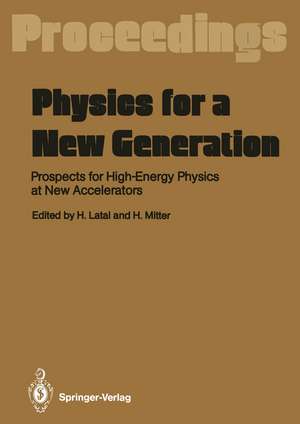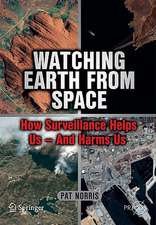Physics for a New Generation: Prospects for High-Energy Physics at New Accelerators Proceedings of the XXVIII Int. Universitätswochen für Kernphysik, Schladming, Austria, March 1989
Editat de Heimo Latal, Heinrich Mitteren Limba Engleză Paperback – 23 noi 2011
Preț: 643.99 lei
Preț vechi: 757.63 lei
-15% Nou
Puncte Express: 966
Preț estimativ în valută:
123.23€ • 131.77$ • 102.74£
123.23€ • 131.77$ • 102.74£
Carte tipărită la comandă
Livrare economică 17 aprilie-01 mai
Preluare comenzi: 021 569.72.76
Specificații
ISBN-13: 9783642755699
ISBN-10: 3642755690
Pagini: 324
Ilustrații: XI, 306 p.
Dimensiuni: 170 x 242 x 17 mm
Greutate: 0.52 kg
Ediția:Softcover reprint of the original 1st ed. 1990
Editura: Springer Berlin, Heidelberg
Colecția Springer
Locul publicării:Berlin, Heidelberg, Germany
ISBN-10: 3642755690
Pagini: 324
Ilustrații: XI, 306 p.
Dimensiuni: 170 x 242 x 17 mm
Greutate: 0.52 kg
Ediția:Softcover reprint of the original 1st ed. 1990
Editura: Springer Berlin, Heidelberg
Colecția Springer
Locul publicării:Berlin, Heidelberg, Germany
Public țintă
ResearchDescriere
th This volume contains the written versions of invited lectures presented at the 28 "Internationale Universitatswochen fUr Kernphysik" in Schladming, Austria in March 1989. The generous support of our sponsors, the Austrian Ministry of Science and Research, the Government of Styria, and others, made it again possible to invite expert lecturers. The courses were centered on elementary particle physics to be performed with large accelerators accessible in the immediate future, including some reports on the current situation. Thanks to the efforts of the speakers it was possible to obtain excellent surveys. After the School the lecture notes were revised and partially rewritten in TPC by the authors, whom we thank for their labour. Unfortunately the report on the situation at SLAC by M. Swartz could not be included. Thanks are also due to the publishers for their patience. Graz, Austria H. Latal December 1989 H. Mitter v Contents Phenomenology of and Beyond the Standard Electroweak Model By A. Bartl, H. Pietschmann, and H. Stremnitzer (With 6 Figures) 1 1. The Standard Model (H. Pietschmann) . . . . . . . . . . . . . . . . . . . . . . . . . . 1 1. 1 Introduction . . . . . . . . . . . . . . . . . . . . . . . . . . . . . . . . . . . . . . . . . . . 1 1. 2 Defining the Standard Model . . . . . . . . . . . . . . . . . . . . . . . . . . . . . 1 1. 3 Testing the Standard Model . . . . . . . . . . . . . . . . . . . . . . . . . . . . . . . 4 1. 4 Predictions . . . . . . . . . . . . . . . . . . . . . . . . . . . . . . . . . . . . . . . . . . . . 5 1. 5 Open Questions . . . . . . . . . . . . . . . . . . . . . . . . . . . . . . . . . . . . . . . . 6 1. 6 Hypotheses. . . . . . . . . . . . . . . . . . . . . . . . . . . . . . . . . . . . . . . . . . . . 6 1. 7 Conclusion . . . . . . . . . . . . . . . . . . . . . . . . . . . . . . . . . . . . . . . . . . . . 9 2. Beyond the Standard Model: Supersymmetry (A. Bartl) . . . . . . . . . . . . 9 2. 1 Supersymmetric Extension of the Standard Model . . . . . . . . . . . . 10 2. 2 Production and Decay of Supersymmetric Particles . . . . . . . . . . . 17 3. Beyond the Standard Model: Composite Models (H.
Cuprins
Phenomenology of and Beyond the Standard Electroweak Model.- 1. The Standard Model (H. Pietschmann).- 1.1 Introduction.- 1.2 Defining the Standard Model.- 1.3 Testing the Standard Model.- 1.4 Predictions.- 1.5 Open Questions.- 1.6 Hypotheses.- 1.7 Conclusion.- 2. Beyond the Standard Model: Supersymmetry (A. Bartl).- 2.1 Supersymmetric Extension of the Standard Model.- 2.2 Production and Decay of Supersymmetric Particles.- 3. Beyond the Standard Model: Composite Models (H. Stremnitzer).- 3.1 Introduction.- 3.2 The Size of Composite Quarks.- 3.3 Quantum Preon Dynamics.- 3.4 Other Features of Composite Models.- References.- Physics at LEP.- 1. Introduction.- 2. LEP Machine.- 2.1 LEP Parameters.- 2.2 Injection System.- 2.3 Luminosity.- 2.4 Status of LEP. Tests and Plans for the Commissioning.- 2.5 Up-grading of LEP.- 3. LEP Detectors.- 4. Physics of the Z0.- 4.1 Z0 Parameters in the Standard Model.- 4.1.1 Branching Ratios. Total Width.- 4.1.2 Z0 Line Shape.- 4.2 Radiative Corrections to the Z0 Mass and Width.- 4.2.1 QED Corrections.- 4.2.2 Weak Corrections.- 4.2.2.1 The On-Mass-Shell Definition of sin2? w.- 4.2.2.2 Introduction of an Effective Weak Angle.- 4.2.3 Hadronic Decays and QCD Corrections.- 4.2.4 Summary of the Radiative Corrections.- 4.3 Strategy to Determine the Z-Parameters from the Line Shape.- 4.4 Asymmetries at the Z0 Peak.- 4.4.1 Definition of Asymmetries.- 4.4.2 AFB and ALRfor Leptons in the Final State.- 4.4.3 Asymmetries for Heavy Quarks.- 4.4.4 Polarization Asymmetry for Tau Decays.- 4.5 Neutrino Counting.- 4.5.1 Neutrino Counting from the Z-Width.- 4.5.2 Radiative Neutrino Counting.- 5. QCD Tests.- 5.1 Cross Section, Thrust, Oblateness and Sphericity.- 5.2 Fragmentation Models.- 5.3 Test of the Non-Abelian Character of QCD.- 6. Search for Supersymmetric Particles.- 6.1 General Remarks.- 6.2 Experimental Searches for Supersymmetric Particles.- 6.2.1 Wino Pair Production.- 6.2.2 Associated Zino-Photino Production.- 6.2.3 Three-Body Final States.- 6.3 Conclusions.- 7. Search for Higgs Particles.- 7.1 General Properties of the Higgs.- 7.1.1 The Standard Model Higgs.- 7.1.1.1 Higgs Decay into Fermions.- 7.1.1.2 Higgs Decay into Bosons.- 7.1.2 The Supersymmetric Higgses.- 7.2 Higgs Search at the Z0 Peak (LEP 100).- 7.2.1 Search for the Standard Model Higgs.- 7.2.2 Search for the SUSY Higgs.- 7.3 Higgs Search at LEP 200.- 7.3.1 Higgs Search Below the WW Threshold (at 160 GeV).- 7.3.2 Higgs Search Above the WW Threshold (at 200 GeV).- 7.4 Higgs from Toponium Decay.- 7.5 Search for Charged Higgses.- 7.6 Light Higgses.- 8. Miscellaneous Topics.- 8.1 Top Search.- 8.2 B-Physics at LEP.- 8.3 Other New Particles.- References.- The HERA Project.- 1. Introduction.- 2. The Machine.- 2.1 Superconducting Magnets.- 2.2 Interaction Region and Spin Rotator.- 3. HERA Physics.- 3.1 Deep Ineleastic Scattering.- 3.1.1 The Standard Prejudice.- 3.1.2 Tests of the Standard Model at HERA.- 3.1.3 Speculations.- 3.2 Particle Production.- 3.2.1 New Particles.- 3.2.2 Heavy Quark Production.- 3.3 W-Production.- 4. Detection Facilities.- 4.1 General Requirements.- 4.2 The HI-Detector.- 4.3 The ZEUS Detector.- 5. Status.- Acknowledgement.- References.- Physics in pp? Collisions.- 1. Introduction.- 2. Production and Decay of IVBs.- 2.1 IVB Masses and Standard Model Parameters.- 2.2 IVB Production Cross-Sections and e-?-? Universality.- 2.3 IVB Transverse-Momentum Distribution.- 2.4 Measurement of ?s Using W + Jet Data.- 2.5 Number of Light Neutrino Species.- 2.6 Outlook.- 3. Heavy-Flavour Production.- 3.1 Inclusive b-Quark Production.- 3.2 B0-B?0 Oscillations.- 4. Search for Heavy Quarks (t, b?).- 4.1 Outlook.- 5. Searches for New Physics.- 5.1 Search for Heavy Leptons and the Number of Neutrino Species.- 5.2 Searches for Supersymmetric Particles.- 5.3 Searches for Additional Vector Bosons.- 5.4 Axigluon Search.- 5.5 Quark Substructure.- 5.6 Outlook.- 6. Conclusions.- References.- Weak Mixing, CP Violation and the Standard Model.- 1. Weak Mixing of Quarks.- 1.1 Kobayashi-Maskawa Matrix.- 1.2 Experimental Constraints on the KM Matrix.- 1.2.1 Light Quark Couplings.- 1.2.2 Charm-Quark Couplings.- 1.2.3 Bottom-Quark Couplings.- 1.3 Allowed Ranges of Mixing Angles for 3 or 4 Generations.- 2. CP Violation.- 2.1 Phenomenology and Models.- 2.2 New Experiments on ??/?.- 3. Implications of Experimental Results on the Standard Model Parameters.- 4. Beyond the Standard Model: Searches for Rare Kaon Decays.- 5. Conclusions — Outlook.- References.- Recent Developments in Perturbative QCD.- 1. Introduction.- 2. General Properties of Perturbative QCD.- 2.1 On the Validity of the Perturbative Description.- 2.2 Theorems of Perturbative QCD.- 2.3 Renormalization.- 2.3.1 Lagrangian.- 2.3.2 Renormalization Factors.- 2.3.3 Comment on the Axial Gauge.- 2.3.4 The Running Coupling Constant.- 2.3.5 The Renormalization Group Equations.- 2.4 The Total Cross Section of e+e? Annihilation into Hadrons.- 2.4.1 Perturbative Expansion to Order ?s3.- 2.4.2 Measurement of R at the Z-Pole.- 3. Deep Inelastic Scattering.- 3.1 Structure Functions and Cross Sections.- 3.2 Phenomenology of the Parton Density Functions.- 3.3 Spin-Dependent Structure Functions.- 3.3.1 The Puzzling EMC Data.- 3.3.2 Large ?s Versus Large ?G.- 3.3.3 The Contribution of the Axial Anomaly.- 3.3.4 Parametrization and Measurement of the Spin-Dependent.- 4. Large Transverse Momentum Reactions in Hadron-Hadron Collisions.- 4.1 ?*-, W- and Z-Production.- 4.1.1 Factorization Theorem for the Drell-Yan Process.- 4.1.2 Total Cross Sections and p?-Distribution.- 4.1.3 Gauge Boson Production in Association with Multi-jets.- 4.2 Heavy Quark Production.- 4.2.1 On the Validity of the Factorization Theorem.- 4.2.2 Cross Section Formulae.- 4.2.3 Phenomenology of Heavy Quark Production.- 5. Jet Production at Next-to-Leading Order.- 5.1 Jet Production in e+e? Annihilation.- 5.1.1 QCD and the Monte Carlo Approach.- 5.1.2 Thrust Distributions.- 5.1.3 Jet Cluster Distributions.- 5.1.4 Inclusive Jet Production.- 5.2 Jet Production in Hadron-Hadron Collisions.- 5.2.1 Partonic Versus Hadronic Jet Cross Sections.- 5.2.2 The Cross Section of Inclusive Jet Production.- References.



